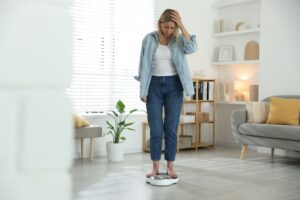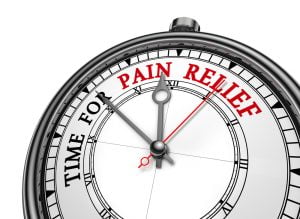Will losing weight help with low back pain?
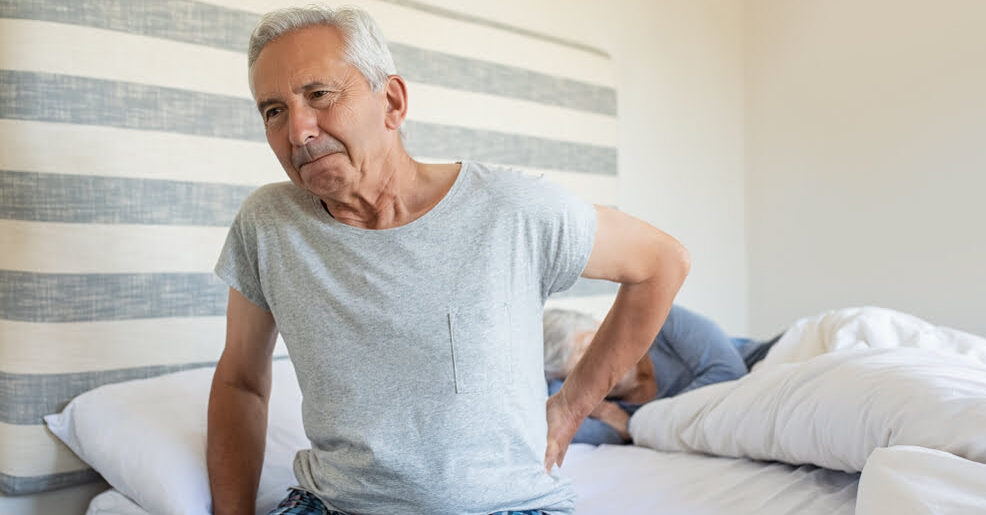
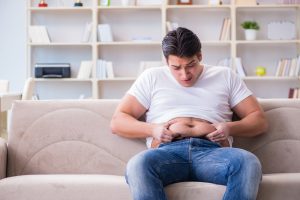 There has been a lot of coverage recently of the benefits of weight loss drugs such as Ozempic and Wegovy, so we thought that it may be a good time to write about how being overweight can affect low back pain. Being overweight carries with it a whole host of health problems, with low back pain being a common problem. People who are obese are up to 1.8 times more likely to have chronic low back pain. (1).
There has been a lot of coverage recently of the benefits of weight loss drugs such as Ozempic and Wegovy, so we thought that it may be a good time to write about how being overweight can affect low back pain. Being overweight carries with it a whole host of health problems, with low back pain being a common problem. People who are obese are up to 1.8 times more likely to have chronic low back pain. (1).
How heavy is overweight?
The most common method of assessing whether a person is overweight or obese is the Body Mass Index (BMI). People having a BMI of between 25-29.9 are classed as being overweight, and people with a BMI higher than 30 are classed as obese. However, the BMI measurement does not consider the different contributions to a person’s weight that come from muscle or fat, or the distribution of the fat on a person’s body, both of which are important predictors of obesity related health problems (2).
 What structures are affected by low back pain?
What structures are affected by low back pain?
Low back pain is the most common musculoskeletal condition across the world’s population (3). Low back pain can have many sources, such as muscle or ligament strains, facet joint dysfunctions, or intervertebral disc disease (IDD) (4).
Intervertebral discs are located between the spinal vertebrae and are responsible for load absorption, movement, and the flexibility of the spine. They are made up of three distinct parts
1 – On the exterior of the disc is the annulus fibrosus, an extremely tough collagen structure that allows multidirectional movement
2 – In the centre of the disc is the nucleus pulposus, a more gel-like structure that accounts for much of the load-bearing ability of the disc.
3 – On the top and bottom of each disc is a cartilaginous end plate which binds the disc to the adjoining vertebrae. The health of the end plate is crucial for the transport of nutrients and waste products to and from the disc (5).
IDD is very common, becoming more prevalent as we age, and its common features include changes to the intervertebral disc, such as fissures in the annulus fibrosus and a loss of the shock-absorbing properties of the nucleus pulposus. This then stimulates the disc to release enzymes that further alter the disc, leading to mechanical instability and possibly nerve sensitization, which can result in pain (6).
How could being overweight affect my low back?
Most people would assume that the heavier a person is, the more mechanical load is being placed on their low back, resulting in an overload of the tissues in the low back and leading to pain. While that is the case, there are more complex processes at play which make being overweight and having low back pain a bit of a vicious cycle (7).
Being overweight or obese is due to excessive fat cells being stored in the body; however, the fat cells present in obesity are dysfunctional and are capable of producing a low-level inflammatory state, leading to pain, and negatively affecting many processes in the body (7).
Mechanical Overload
Being overweight or obese has several mechanical effects on the spine and discs which are mainly due to the weight of the person exceeding the strength threshold of what the tissues can handle (8). Where the excess fatty cells are deposited can also play a part, with people who have more abdominal fat showing higher loads on the spine and a higher incidence of low back pain (9). Being overweight also results in postural changes which affect spinal biomechanics with obese individuals showing increased curvature in the spine and less mobility (10). There are also more specific segmental changes with larger forces being exerted upon the very lowest disc in overweight people who have more shear forces exerted on this area when bending forwards and walking (7).
Biochemical Effects
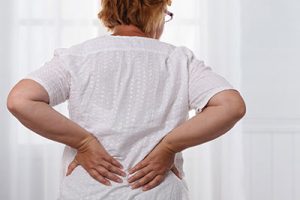 The different tissues of the spine are also chemically affected by obesity.
The different tissues of the spine are also chemically affected by obesity.
Intervertebral Disc – If you have a high-fat diet, which commonly results in obesity, this can result in an increase in the number of lipids in the body, negatively affecting the structure of the disc, resulting in changes similar to IDD, and an increase in inflammation leading to pain (11). The cartilaginous end plate can also become calcified, reducing the disc’s ability to obtain nutrients and get rid of waste, which reduces the health of the disc (12).
Facet Joints – These joints, along with the intervertebral disc, are responsible for movement and stability of the spine. Like most joints in the body, they have cartilage to aid smooth movement. In obese people, the cartilage is subject to an increased rate of loss leading to changes that eventually become osteoarthritis, restricting movement and increasing pain. This is due to both the mechanical stress of being overweight, as well as the negative effects of high levels of lipids in the body, which affect the ability of the bone to remodel sufficiently (7, 13).
Spinal Muscles – The effect of obesity on spinal muscles is also two-fold, in that increased weight leads to fatigue of the muscles, increasing the risk of strain. Also, the muscles themselves are subject to fatty deposits at the expense of muscle fibres, leading to a further strength reduction which in turn makes the structures of the spine more vulnerable to the changes seen in IDD and chronic low back pain (14). Reductions in the thickness of the multifidus muscles and external obliques are commonly seen in people with a high BMI, and the overall effect of obesity on spinal muscles is more common in women than men (7).
Epidural Fat – There is fat present in the spinal core to help cushion the spinal cord. People with obesity have an excess accumulation of epidural fat that can lead to compression of the spinal nerves, leading to pain and other symptoms like numbness and weakness (15).
Nervous System – The function of the nervous system may also be altered in people who are obese. Adipokines are substances produced by fat cells that can increase inflammation in the nervous system and lead to a ‘sensitisation’ which is common in chronic pain. Also, researchers have found that mice fed either a high-fat diet became more sensitive to pain and moved around less. High-fat diets have been shown to affect the nervous system in rats by causing brain inflammation and interfering with how the body processes nerve signals, which can make the body more sensitive to pain (7).
So what can be done to help?
With all the negative effects that being overweight has on low back pain, the most obvious reparative course of action would be for a person to lose weight through lifestyle modification. Surprisingly, there is a lack of strong evidence for weight loss through lifestyle modification as a method of reducing low back pain; the studies are few and far between and generally of low quality (7). However, that does not mean that losing weight will not help…… The most accessible options that help people lose weight are exercise and reducing food intake, both of which individually have been shown to help low back pain.
Increasing physical activity in general is strongly associated with both the alleviation and prevention of low back pain (16), and people who increase their strength through exercise are even less likely to suffer from low back pain (17). When very obese people have bariatric surgery to restrict their food intake, their BMI falls dramatically, and they have a reduction in low back pain (18). So, if we combine those two elements, it would seem likely that reducing weight through diet and exercise would help with low back pain.
If we move away from looking at the effect of losing weight on low back pain specifically, the good news is there is plenty of evidence to suggest that losing some weight will have a measurable difference on pain in other parts of the body. Recent research shows that a baseline of 10% of bodyweight lost will result in significant improvements in pain and function in people with knee osteoarthritis (19). At the more extreme end of this type of research, people who underwent gastric band surgery and lost 20% of their bodyweight reported improvements in overall pain scores of 50% (20).
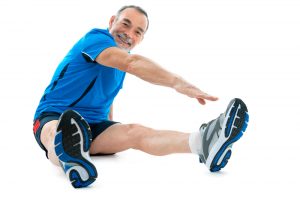 If losing weight were easy, then we would not have an obesity crisis in the UK. Obesity is a multifactorial condition that is contributed to by activity levels, hormonal disorders, lack of sleep, medications, lack of access to effective nutrition, and a myriad of cultural and societal factors including poverty (especially in children). It should also be noted that there is an extremely strong genetic link with several inheritable genes that predispose people to weight gain (21). With these factors in mind, however a person chooses to lose weight, be it through exercise, diet, surgery, or Ozempic, etc, there is a good chance (as well as improving their overall health) that it will help their low back pain.
If losing weight were easy, then we would not have an obesity crisis in the UK. Obesity is a multifactorial condition that is contributed to by activity levels, hormonal disorders, lack of sleep, medications, lack of access to effective nutrition, and a myriad of cultural and societal factors including poverty (especially in children). It should also be noted that there is an extremely strong genetic link with several inheritable genes that predispose people to weight gain (21). With these factors in mind, however a person chooses to lose weight, be it through exercise, diet, surgery, or Ozempic, etc, there is a good chance (as well as improving their overall health) that it will help their low back pain.
Do you want to know what is causing your pain and if we can help? Why not take advantage of our new patient assessment introductory offer to get you started towards a tailor-made recovery plan for only £19.
Are you in a lot of pain and want to get better as soon as possible? If so, then why not book in for a new patient consultation, with treatment on the day, for £75.
References
1 – Shiri, R.; Karppinen, J.; Leino-Arjas, P.; Solovieva, S.; Viikari-Juntura, E. The association between obesity and low back pain: A meta-analysis. Am. J. Epidemiol. 2010, 171, 135–154.
2 – Romero-Corral, A.; Somers, V.K.; Sierra-Johnson, J.; Thomas, R.J.; Collazo-Clavell, M.L.; Korinek, J.; Allison, T.G.; Batsis, J.A.; Sert-Kuniyoshi, F.H.; Lopez-Jimenez, F. Accuracy of body mass index in diagnosing obesity in the adult general population. Int. J. Obes. 2008, 32, 959–966.
3 – GBD 2021 Low Back Pain Collaborators. Global, regional, and national burden of low back pain, 1990–2020, its attributable risk factors, and projections to 2050: A systematic analysis of the Global Burden of Disease Study 021. Lancet Rheumatol. 2023, 5, e316–e329.
4 – Diwan, A.D.; Melrose, J. Intervertebral disc degeneration and how it leads to low back pain. JOR Spine 2023, 6, e1231
5 – Waxenbaum JA, Futterman B. Anatomy, Back, Intervertebral Discs. InStatPearls [Internet] 2018 Dec 13. StatPearls Publishing. Available from: https://www.ncbi.nlm.nih.gov/books/NBK470583/
6 – Rustenburg, C.M.E.; Emanuel, K.S.; Peeters, M.; Lems, W.F.; Vergroesen, P.A.; Smit, T.H. Osteoarthritis and intervertebral disc degeneration: Quite different, quite similar. JOR Spine 2018, 1, e1033
7 – Ruiz-Fernandez, C.; Schol, J.; Ambrosio, L.; Sakai, D. The Vicious Cycle of Obesity and Low Back Pain: A Comprehensive Review. Appl. Sci. 2025, 15, 6660. https://doi.org/10.3390/app15126660
8 – Ghezelbash, F.; Shirazi-Adl, A.; Plamondon, A.; Arjmand, N.; Parnianpour, M. Obesity and Obesity Shape Markedly Influence Spine Biomechanics: A Subject-Specific Risk Assessment Model. Ann. Biomed. Eng. 2017, 45, 2373–2382
9 – You, Q.; Jiang, Q.; Li, D.; Wang, T.; Wang, S.; Cao, S. Waist circumference, waist-hip ratio, body fat rate, total body fat mass and risk of low back pain: A systematic review and meta-analysis. Eur. Spine J. 2021, 31, 123–135.
10 – Valdovino, A.G.; Bastrom, T.P.; Reighard, F.G.; Cross, M.; Bartley, C.E.; Shah, S.A.; Yaszay, B.; Newton, P.O.; Upasani, V.V. Obesity Is Associated with Increased Thoracic Kyphosis in Adolescent Idiopathic Scoliosis Patients and Nonscoliotic Adolescents. Spine Deform. 2019, 7, 865–869.
11 – Zhang, X.; Chen, J.; Huang, B.; Wang, J.; Shan, Z.; Liu, J.; Chen, Y.; Li, S.; Fan, S.; Zhao, F. Obesity Mediates Apoptosis and Extracellular Matrix Metabolic Imbalances via MAPK Pathway Activation in Intervertebral Disk Degeneration. Front. Physiol. 2019, 10, 1284.
12 – McDonnell, E.E.; Buckley, C.T. Consolidating and re-evaluating the human disc nutrient microenvironment. JOR Spine 2022, 5, e1192.
13 – Luo, X.H.; Guo, L.J.; Yuan, L.Q.; Xie, H.; Zhou, H.D.; Wu, X.P.; Liao, E.Y. Adiponectin stimulates human osteoblasts proliferation and differentiation via the MAPK signaling pathway. Exp. Cell Res. 2005, 309, 99–109.
14 – Özcan-Ekşi, E.E.; Turgut, V.U.; Küçüksüleymanoğlu, D.; Ekşi, M.Ş. Obesity could be associated with poor paraspinal muscle quality at upper lumbar levels and degenerated spine at lower lumbar levels: Is this a domino effect? J. Clin. Neurosci. 2021, 94, 120–127.
15 – Walker, P.B.; Sark, C.; Brennan, G.; Smith, T.; Sherman, W.F.; Kaye, A.D. Spinal Epidural Lipomatosis: A Comprehensive Review. Orthop. Rev. 2021, 13, 25571.
16 – Jenkins, H.J.; Correa, L.; Brown, B.T.; Ferreira, G.E.; Nim, C.; Aspinall, S.L.; Wareham, D.; Choi, J.; Maher, C.G.; Hancock, M.J. Long-term effectiveness of non-surgical interventions for chronic low back pain: A systematic review and meta-analysis. Lancet Rheumatol. 2025, in press.
17 – Wang, P.; Lu, X.; Wen, M.; Li, X.; Gao, Q.; Qin, R. Association between muscle strength and low back pain among middle-aged and older adults: A cross-sectional study. BMC Public. Health 2025, 25, 1869
19 – Christensen R, Bartels EM, Astrup A, Bliddal H (2007). Effect of weight reduction in obese patients diagnosed with knee osteoarthritis: a systematic review and meta-analysis. Ann Rheum Dis; 66:433–439.
20 – Richette P, Poitou C, Garnero P, Vicaut E, Bouillot JL, Lacorte JM, et al (2011). Benefits of massive weight loss on symptoms, systemic inflammation and cartilage turnover in obese patients with knee osteoarthritis. Ann Rheum Dis; 70:139–144.
21 – Panuganti KK, Nguyen M, Kshirsagar RK. Obesity. [Updated 2023 Aug 8]. In: StatPearls [Internet]. Treasure Island (FL): StatPearls Publishing; 2025 Jan-. Available from: https://www.ncbi.nlm.nih.gov/books/NBK459357/

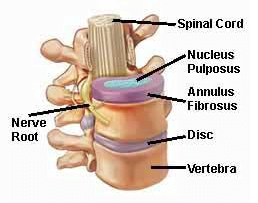 What structures are affected by low back pain?
What structures are affected by low back pain?